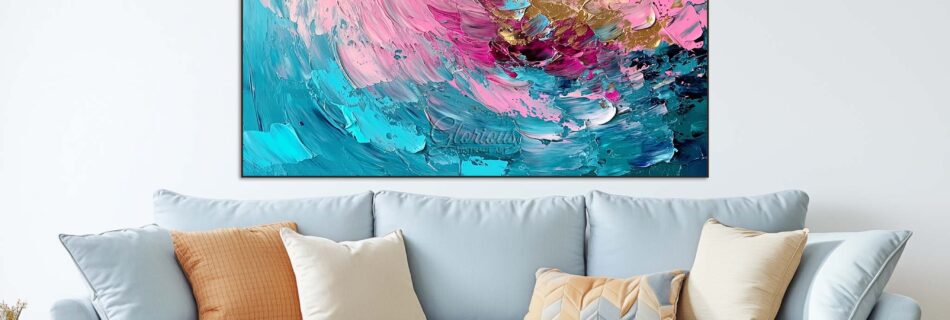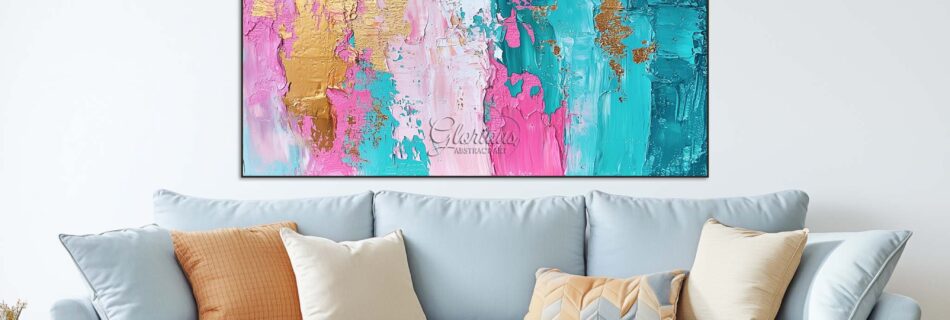Abstract Landscape Paintings: Blending Nature and Imagination
Abstract landscape paintings hold a unique allure, capturing the essence of nature through the lens of artistic interpretation. These artworks transcend the literal representation of trees, mountains, and water, instead focusing on conveying the emotions, sensations, and memories associated with the natural world. At Glorious Abstract Art, we celebrate this fascinating genre, showcasing a diverse collection of handmade abstract landscape paintings perfect for adding a touch of sophistication and intrigue to your home decor. The Allure of Abstract Landscapes What makes abstract landscape paintings so captivating? Firstly, they invite viewers to actively engage with the artwork, interpreting the shapes, colors, and textures in their own personal way. There is no single “correct” way to see an abstract landscape, making each viewing experience a unique journey of discovery. Secondly, abstract landscapes possess a timeless quality. While styles and trends in art may come and go, the focus on fundamental elements like color, form, and composition ensures that these paintings remain relevant and engaging for generations. Thirdly, these artworks offer a sense of freedom and escape. By moving away from strict realism, abstract landscapes allow us to connect with nature on a deeper, more emotional level. They evoke feelings of peace, tranquility, awe, and wonder, enriching our living spaces with their evocative power. Techniques and Styles in Abstract Landscape Painting Contemporary artists employ a wide range of techniques and styles to create their abstract landscape paintings. Some common approaches include: Impressionistic Abstraction: These paintings capture the fleeting impressions of light and color in a landscape, often using visible brushstrokes and a vibrant palette. Geometric Abstraction: This style reduces landscapes to their basic geometric forms, such as squares, triangles, and circles. It emphasizes structure, order, and harmony. Lyrical Abstraction: Characterized by flowing lines, soft colors, and a dreamy atmosphere, lyrical abstraction conveys the emotional essence of a landscape. Gestural Abstraction: Also known as action painting, this style emphasizes the physical act of painting itself, with expressive brushstrokes and dynamic compositions. Choosing the Right Abstract Landscape Painting for Your Home When selecting an abstract landscape painting for your home decor, consider the following factors: Color Palette: Choose colors that complement your existing decor and create the desired mood in the room. Do you want a calming blue and green palette or a more vibrant mix of oranges and reds? Size and Scale: Select a painting that is appropriately sized for the wall where it will be displayed. Consider the scale of the room and the surrounding furniture. Style and Composition: Choose a style that resonates with your personal taste and complements your overall decor. Do you prefer bold, geometric shapes or soft, flowing lines? Orientation: Decide whether you want a horizontal (landscape) or vertical (portrait) orientation. Consider the shape of the wall and the surrounding architecture. Where to Buy Abstract Landscape Paintings If you’re looking to add an original abstract landscape painting to your art collection, you’ve come to the right place. At GloriousAbstractArt, we offer a curated selection of handmade abstract paintings, including a variety of captivating landscapes. Our collection features works by talented artists who skillfully blend nature and imagination. Invest in a Unique Piece of Art Investing in an original abstract landscape painting is more than just buying a piece of decor. It’s about acquiring a unique work of art that will enrich your life for years to come. These paintings have the power to transform your living space, adding beauty, depth, and meaning to your everyday life. Experience the Beauty of Abstract Landscapes Today We invite you to explore our collection of abstract landscape paintings at Glorious Abstract Art. Discover the perfect piece to complement your home decor and express your unique style.





